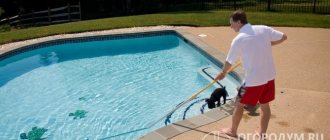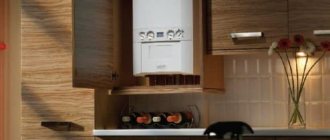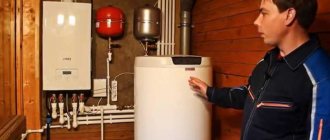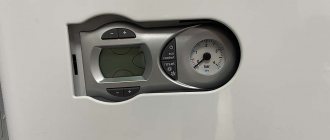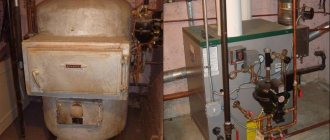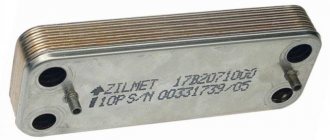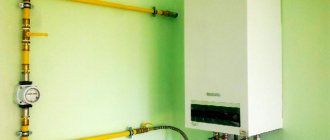How to heat water
The use of electric boilers guarantees a constant flow of liquid with the need to arrange a separate compartment for installation.
Flow devices take up little space and are made of heat-resistant plastic, stainless steel, and titanium.
Advantages:
- fast heating;
- automation of the entire process;
- installation of thermostatic relays;
- Compact, easy to install.
Heating of swimming pools using a heat exchanger can be organized by connecting to a common system. Temperature adjustment is not required: this parameter is monitored by the automatic component of the gas or solid fuel boiler. The working elements are placed between the circulation pump and the cleaning station. This solution makes it possible to reduce the impact of reagents on the coil and associated parts. For hard water with high chlorine content, it is better to use an internal circuit made of titanium or stainless steel.
Heating a home using solar energy has recently been developed. In hot weather, the water in the pool heats up naturally. To maintain a comfortable temperature, the construction of a solar collector is required. It accumulates energy, transferring it to liquids on cloudy and cold days.
Boiler models for heating water with gas, prices
Popular models of gas heaters for swimming pools are the following:
Vanward Tankless
Affordable gas pool heater made in China. Suitable for small medium bowls for home use . Compliance with ISO9001 standards certifies the high quality and safety of the product.
The compact size of the device allows it to be installed in limited spaces. The average cost of such a heater is from 15,000 to 16,000 rubles.
Volcano
Gas heaters of the Vulcan brand are compact, easy to use and efficient . Suitable for stationary, quickly installed and swimming pools.
The supply type of heater requires its connection to a water filtration system, the productivity of which should be in the range from 2 to 9 thousand liters per hour. The cost of the model is 30-35 thousand rubles.
Davey
Davey gas heaters are suitable for large-volume amateur and professional pools. They are used in SPA centers, swimming establishments and private residential properties (country houses, cottages, dachas).
HSI (hot surface ignition) technology has been introduced, which reduces fuel consumption by reducing pilot light consumption. The average cost of the model is about 220-250 thousand rubles.
Methods for calculating the power of a gas boiler
In order for the gas heating circuit to work correctly, you should use the empirical formula t = 1.16xVxT/P, where t is the required time in hours, V is the number of cubic meters (volume of water) in the pool, T is the desired temperature difference in °, P is the indicator power declared by the manufacturer.
In this way, the required time for heating water in a bath or pool using standard heat exchangers from main fuel or gas in cylinders is calculated.
If the liquid has a temperature of 19 °C, and it needs to be heated to 25 °C (by 6 °C with an object volume of 30 cubic meters), then the time determined by the formula t = 1.16x30x6/6 will be 34.8 hours.
How to use?
To start heating, it is enough to provide gas supply to the device and turn on the equipment with the appropriate switch. Next, after the operating time of the heat exchanger, previously calculated by the appropriate formula, you need to check the temperature in the pool.
It should correspond to the expected value: swimming pools, sports pools - from 24 to 26 degrees Celsius, children's pools - from 28 to 30 degrees Celsius, pools for hydromassage and similar water treatments - from 32 to 38 degrees Celsius.
Using a special film to preserve heat
A thermal blanket will help heat the water in the pool. The canvas is pulled over the object, and heat will not be reflected from the water, being retained by the film.
This method helps to increase the temperature of the top layer of water by 4-5 °C. For uniform maintenance, you will need to turn on a pump that mixes the liquid. The film is produced according to standard pool sizes or cut to fit a homemade design.
Advantages:
- acceptable price;
- ease of operation (without the participation of specialists);
- protection from falling leaves, insects, and other debris.
The disadvantages include the inability to use film as the main method of heating water.
Does it matter?
Heating water is a physical process that occurs under certain conditions. They can promote or hinder the heating of water, since the transfer of thermal energy is always interconnected with all surrounding objects or factors.
Planning for the creation of a heating system must be done taking into account the characteristics of the pool and its specific properties.
Bowl type
The type and design of the bowl can affect the heating mode in a very direct way. For example, the depth of the pool determines the effectiveness of heating using solar rays.
In addition, if the pool is deep, then the volume of water that needs to be heated increases. For this, more thermal energy is consumed, i.e. a higher power heater is required.
There are conventional and frost-resistant pool designs.
The former must be drained and stored indoors at the end of the swimming season (most often such models are bought for a summer residence), the latter can be left filled with water for the winter.
The walls of the bowl in frost-resistant species are more durable, assembled from several layers. They are able to resist the effects of low temperatures and frosty expansion of water.
Frost-resistant bowls retain thermal energy better, which makes it possible to reduce the power of heaters.
Manufacturer
The heating method does not depend on the manufacturer (be it Intex, Bestway or any other company), since in any case there is a certain volume of water. Only the enclosure of the bowl changes, which practically does not affect the temperature inside.
Tips and tricks for DIY pool heating
Solar collectors can heat the pool up to 30 °C. This performance is achieved due to complete tightness and installation of water heating in accordance with the manufacturer’s instructions. It’s not that difficult to build the structure in question with your own hands. You will need the skill of construction work with the installation of elements strictly according to the instructions provided.
Knowing how a pool heating system works on a gas or electric boiler, you can bring your planned project to life. This does not require a lot of money and effort.
Operating conditions and selection aspects
The desire to extend the period of use of a pool at the dacha is natural. It is pleasant to plunge into warm water in late spring and early autumn. Not everyone is the owner of a hardened body and has the inclinations of walruses; a comfortable water temperature is also necessary for children. According to existing sanitary rules, along with compliance with the chemical composition, the temperature regime for swimming pools is set within the following limits:
| Category | Temperature, оС |
| Bathing adults | 24-28 |
| Wellness treatments | 26-29 |
| Children under 7 years old | 30-32 |
| Children over 7 years old | 29-30 |
| Hot tubs | 35-39 |
Based on the above standards, owners of swimming pools in their country houses should decide on methods of heating water. For these purposes, the following equipment is used:
- flow electric heaters;
- heat exchangers;
- solar panels;
- heat pumps;
- other methods (fuel-fired water heaters, heating blankets, etc.).
When choosing the appropriate option for heating water at your dacha, the following factors are taken into account:
- the size of the pool and the volume of water to be heated;
- location of communications;
- personal preferences of the owner.
Let's move on to a description of the features of each method.
Types of outdoor heated swimming pools for the dacha
There are many types of structures that can be used in the countryside - from the simplest portable options to expensive systems with all the necessary functionality. Decide on what to choose based on your needs, frequency of use and budget.
Important! Both types of pools presented below can have a heating function - either built-in or manual. There is no need to exclude cheaper inflatable models from your purchase search.
Frame
Such pools can also be transported, easily stored and they take up little space, but in addition to the main tank they are also equipped with a durable frame. The frame provides stability and safety, allows the structure to withstand greater weight of vacationers and a large volume of water, and can also have additional functions (for example, hydromassage).
Inflatable
Simple and cheap pools are usually purchased for children and have an appropriate size, but there are also “adult” and “family” options that can accommodate an adult or even several. Such pools are not very durable, but they are inexpensive and easy to use - they can be replaced once every one or several seasons.
Basic methods of heating pool water
Typically, frame pools have a full-fledged heating system - they are equipped with special electrical parts that ensure water heating. The more powerful such a system, the more carefully you should handle the device. A heated country pool must, above all, be safe.
Flow-through electric heater
The operating principle of such a device is similar to that used to heat “stationary” swimming pools. The water circulation and the heating device interact in such a way that the water is constantly heated and remains within acceptable temperature limits.
Heat pump
Another option that requires electricity. The pump itself is located outside and provides power to the parts of the pool itself. This method is quite safe, although a pool with it requires a little more effort in storage and proper operation. The most common cause of malfunction, in addition to mechanical damage, is failure of the pump itself.
Heat exchanger
An external device that provides heat flows into the tank. The heat exchanger also requires electricity, but can also be wireless (on charge). A good alternative to the two previous options, if we are not talking about installation on the site, but about going out into nature, for example.
Solar panels
Solar panels allow you to generate energy completely autonomously, without the use of batteries or direct sources of electricity. The only downside to solar panels is that you have to wait until they are fully charged. Also, if there is no sun, you will not be able to charge the pool. These disadvantages are compensated by the ability of modern panels to accumulate energy. A heated frame swimming pool for your dacha and a set of small solar panels will provide you with a pleasant holiday at any time.
How to make a solar collector for a swimming pool with your own hands
With your own hands and from scrap materials, you can make a simplified version of a flat-plate solar collector. But the design is suitable for use only in summer; in winter it is ineffective. It is extremely important to assemble and connect the device correctly.
Necessary materials
To make the collector you will need:
- plastic pipes;
- wooden beam with a section of 5x5 cm;
- thin slats;
- plywood;
- black paint;
- metal corner;
- metal sheets;
- self-tapping screws;
- small water pump;
- geoglass;
- tees;
- mineral wool.
- Exhaust valve;
- drain tap.
To make the collector you will need plastic pipes.
To create a cushion under the system you will need sand, gravel and geotextiles. You need to purchase consumables for the welding machine in advance.
Build process
The manifold assembly process includes the following steps:
- Make a frame from wooden slats and cover it with plywood.
- Place insulation on the bottom and make a sheathing of thin slats.
- Attach thin metal plates to the surface.
- Paint the entire structure black.
- Cut the pipes and connect them together with fittings and angles to form a coil.
- Mount pipe fasteners on the surface of the shield.
- Fix the coil on the frame and paint it black
- Carry out a hydraulic test.
- Equip the inlets and outlets of the coil using tees and shut-off valves.
- Cover the top of the structure with geoglass.
From steel corners you need to weld a platform on which the entire system will be mounted.
Installation and connection of the solar collector
First of all, you need to choose a good site for installing a solar collector. Homemade structures are often less efficient than professional ones, so it is better to place them in close proximity to the pool - this will reduce heat loss during water circulation.
Connecting a solar collector reduces heat loss.
The selected place should be prepared: remove the top soil layer and form a sand and gravel cushion. Then the surface is carefully leveled and a layer of concrete is poured. If desired, the platform can be made from paving slabs.
After this, a metal frame is installed.
The next step is to install the collector on the platform. It is important that it faces south. Then a medium-power pump is connected - it will ensure a slow flow of water through the system and better heating.
At the final stage, the efficiency of the collector is checked.
Preparing for work
Making your own water heater for a swimming pool means you can save a lot on the purchase of expensive equipment. Using solar energy for heating is the best option to save both your money and thermal energy.
Material selection and tips
You will need quite a lot of materials to create a solar heater, but you should not skimp on them - all your costs will pay off in the first few weeks of operation. The most common wood can be used, for example, pine. Before using it, it is recommended to treat the surface with a special antiseptic to prevent rotting or the formation of pests. It is recommended that you initially buy the highest quality, albeit expensive, fasteners and adapters for assembling the manifold.
Tools
- Beam with a square section of 50 mm - 38 m.
- Plywood 12–15 mm thick - 5 m².
- Metal-plastic pipe with a diameter of 0.5 inches - 110 m.
- Plastic fasteners for pipes - 160 pcs.
- Carbon adapter for metal-plastic pipes of the male-female type - 60 pcs.
- Carbon adapter for metal-plastic pipes of the “female-female” type - 62 pcs.
- Adapter for fitting with a diameter of 0.5 inches - 105 pcs.
- Air outlet valve - 1 pc.
- Check valve - 1 pc.
- Tee with a diameter of 0.5 inches - 3 pcs.
- Drain tap with a diameter of 0.5 inches - 2 pcs.
- Submersible pump 3–4 m³/h – 1 pc.
- Corrugated hose - 2 pcs.
- Sheet metal - 5 m².
- Aluminum profile 12 cm high - 4 pcs.
- Steel corner (galvanized) 50x100 mm – 4 pcs.
- Glass 4 mm thick - 4 pcs.
- Black nitro paint - 5 l.
- Board 30x100 mm - 9 m.
- Ruberoid (or other rolled waterproofing) – 5 m².
- Paving slabs from 40 mm thick - 4 m².
- Self-tapping screws for wood.
- Plumbing fum tape.
- River sifted sand.
- Silicone sealant.
Heat pumps
A relatively new way to heat a pool in a country house is to install a heat pump. Among the significant advantages of the equipment is the speed of heating water; the high cost of the product may become a limitation for the purchase. The operating principle is as follows:
- The primary source of heat can be domestic or industrial treated wastewater.
- The working fluid moves through a pipeline located underground due to the operation of a circulation pump.
- Then the mixture moves to the heat exchanger.
- After heat is transferred to the refrigerant, it boils (even a low temperature will be enough for this).
- The boiling process is accompanied by the formation of steam, which, after entering the compressor, is compressed to 25 atmospheres.
- This promotes heating to 55°C.
After reaching the required temperature, the water moves into the pool. An important advantage of the system is the ability to use the heat of the earth or exhaust gases, which are free sources of energy, to heat the pool at the dacha.
Maintenance and care
During operation, the pool does not require complex maintenance. If you have electrical components, regularly check their serviceability. It is also necessary to clean it, preferably after every bath. If the model you purchased does not have a filtration system, clean it by hand or drain the water completely.
Care involves proper storage. Before storing your pool, make sure it is completely dry. It is recommended to deflate completely and place it in a dry place, away from any heat sources.
Advantages and disadvantages of heated swimming pools
A heated swimming pool for a summer cottage is an excellent means of relaxation and safe entertainment for children, but before purchasing one for your property, it is advisable to familiarize yourself with all the pros and cons.
The advantages of such pools:
- healthy and fun water procedures in the fresh air;
- safe entertainment for kids (if the pool is of appropriate depth);
- easy to store, carry within the site and take with you when folded.
Minuses:
- careful care is required during use and storage - otherwise pathogenic bacteria will grow in a humid environment;
- most models, even in the middle price segment, break easily;
- If the heating system is built-in, then the pool may be dangerous due to electrical parts.
The simplest solar water heater - DIY instructions
From scrap materials you can make simple solar water heaters that are highly efficient in the summer. Cellular polycarbonate and plastic bottles will serve as a good basis for creating such devices.
Made from cellular polycarbonate
First, a frame is made from a wooden beam. Then a coil is welded from copper tubes in which water will circulate. At its ends, fittings are installed to connect the supply and discharge pipes.
The water heater can be made of cellular polycarbonate.
Plywood is attached to one side of the frame, and insulation is placed on top of it. After this, the coil is fixed to the frame. The top of the structure is covered with a polycarbonate sheet. The finished collector is connected to the pump. In addition, a pipe is installed that drains the liquid back into the pool. You can then turn on and test the system.
From plastic bottles
For the manufacture of the device, containers with a volume of 1.5 liters are better suited. A hole should be drilled in the bottom of each of them, the diameter of which should coincide with the neck. Then one bottle is inserted into the other, secured together with a drilled cap. The connections should be soldered so that they are airtight. In this way, 5-6 containers are fastened in a row.
You need to make at least 5 of these batteries. They are connected to each other with a hose to form a coil. The bottles are painted black. Then the formed coil is placed in a pre-made housing, in which the inlet and outlet holes are made. The top of the heater is covered with transparent polycarbonate or glass.
